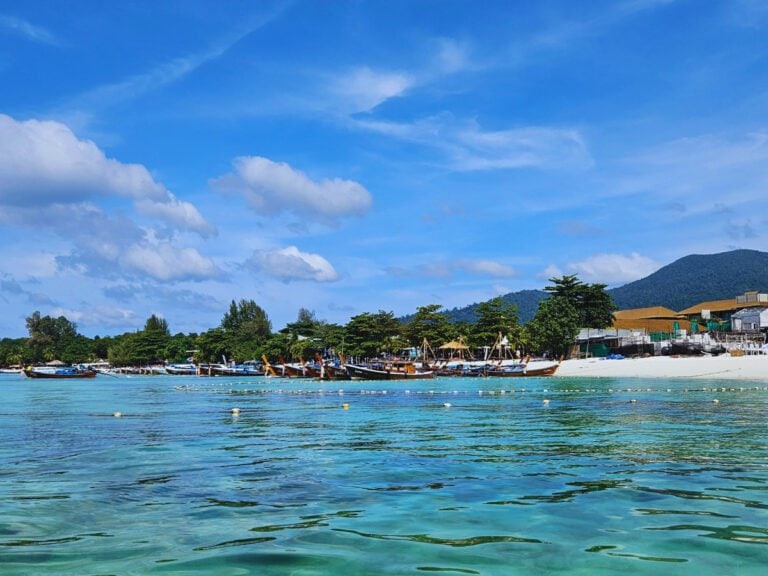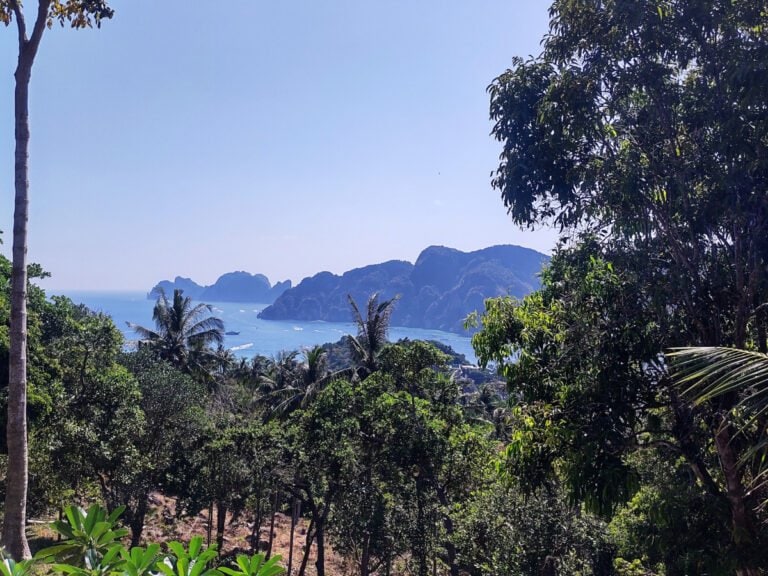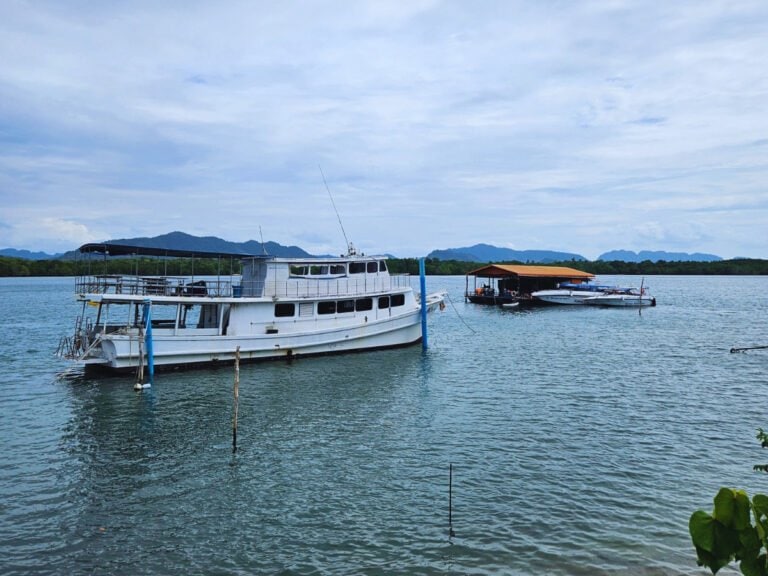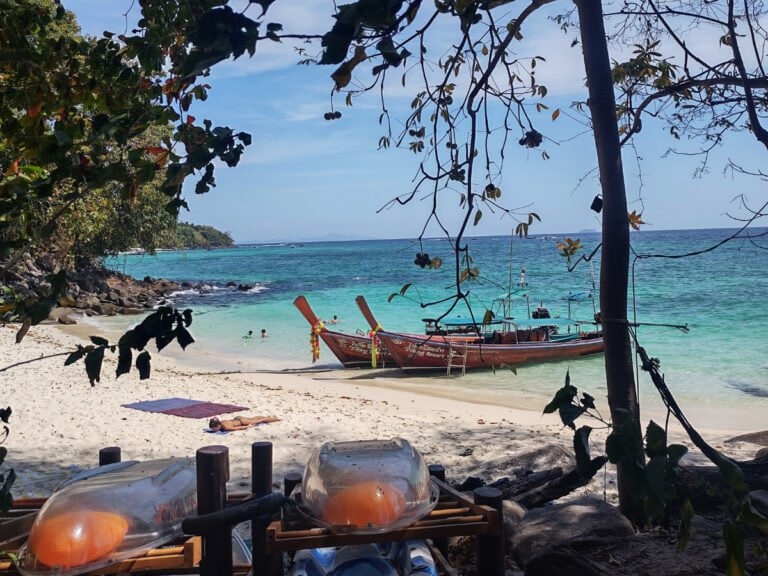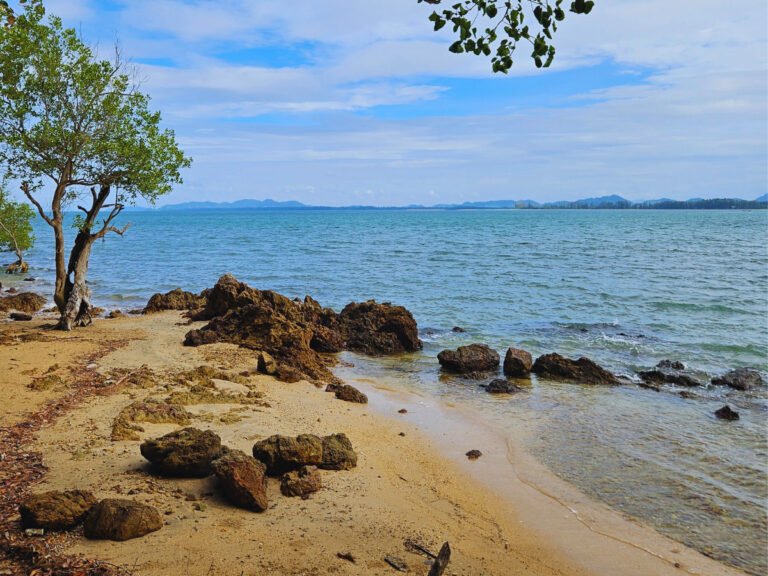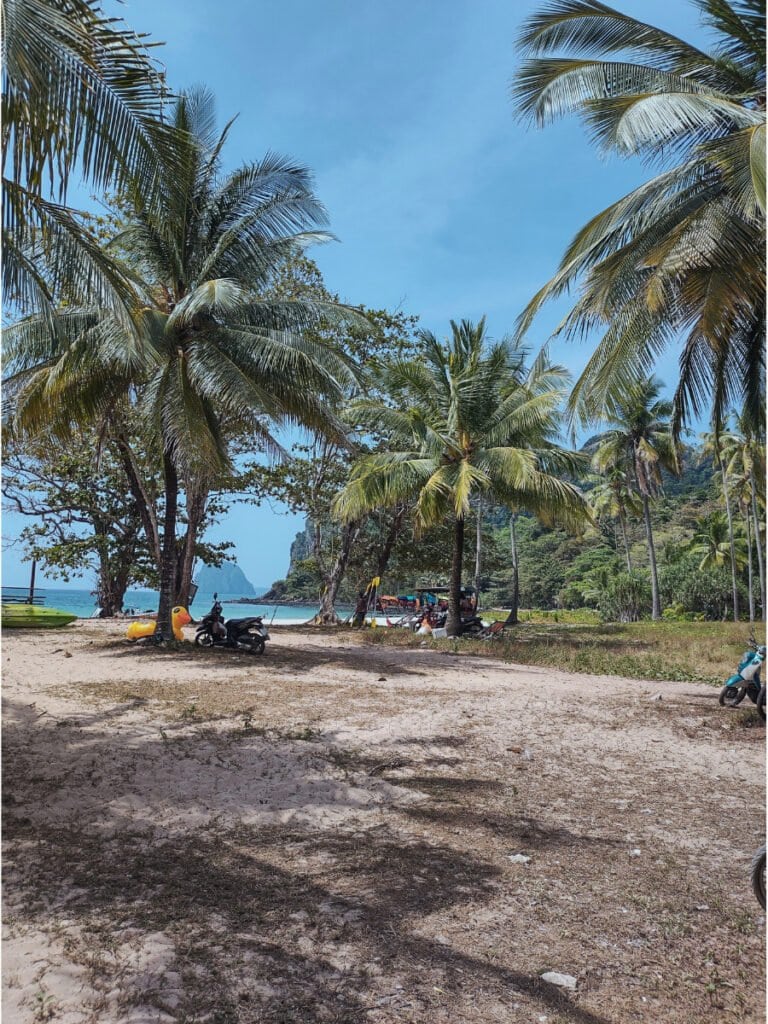Koh Lipe vs. Koh Mook vs. Koh Lanta vs. Koh Phi Phi: The Ultimate Guide to Choosing Your Perfect Southern Thai Island Adventure (2024)
When planning a trip to Southern Thailand, choosing the right island can feel overwhelming, especially if you’re seeking authentic and adventurous experiences.
The Andaman Sea is home to some of Thailand’s most captivating islands, including Koh Lipe, Koh Mook, Koh Lanta, and Koh Phi Phi.
Having spent several days on each of these islands during my month-long journey through southern Thailand, I can confidently say that each offers something unique for travelers who want to immerse themselves in nature and enjoy thrilling adventures.
In this comprehensive guide, I’ll share my firsthand knowledge and insights to help you decide which island best suits your expectations.
Read on to discover your next unique island adventure in Southern Thailand!
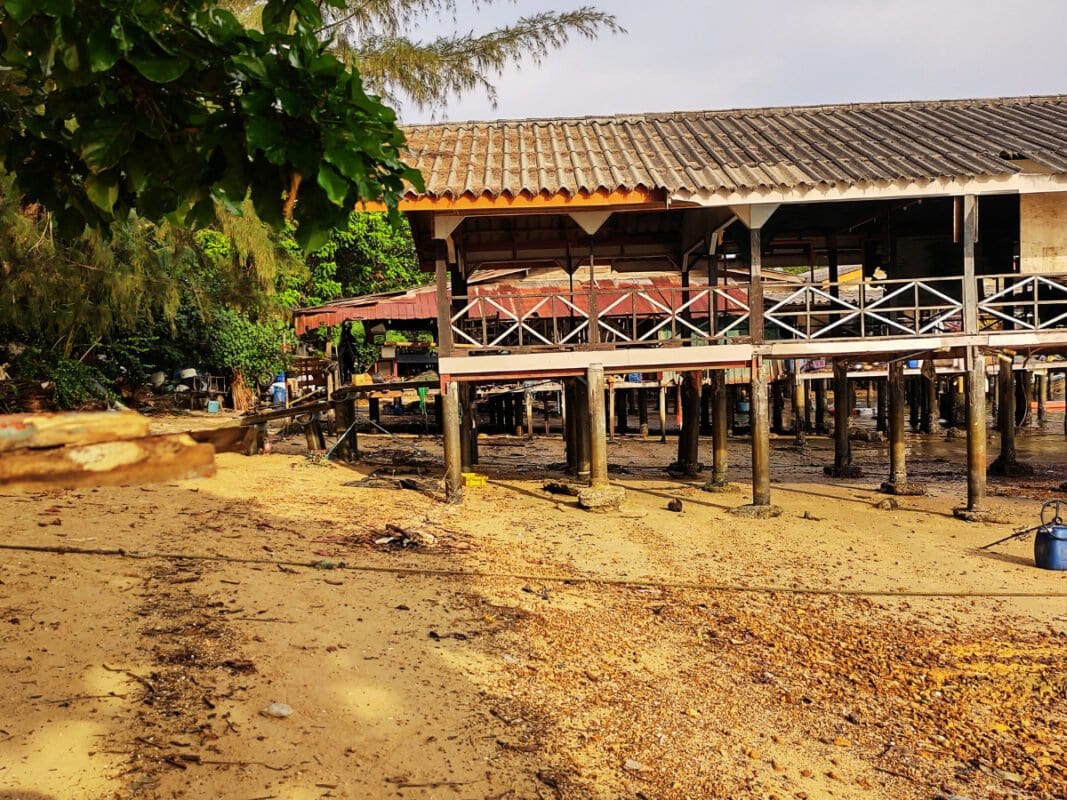
Location
Koh Lipe
Koh Lipe is the southernmost Thai island, located 60 km (37 miles) from Malaysian island of Langkawi, making it closer to Malaysia than most other Thai islands.
You will find an immigration office on Koh Lipe and entrance to Tarutao National Marine Park. Neighboring Thai islands like Koh Adang and Koh Rawi are easily accessible by short boat trips.
Speedboats from Phuket, Koh Lanta and Krabi operate regularly during the dry season, but the journey takes 5-6 hours and can be rough, due to large waves.
Getting to Koh Lipe from Bangkok is relatively straightforward and can be done in half a day. You can fly from Bangkok to Hat Yai or Trang Airport (about 1.5 hours flight), followed by a shared van or taxi ride to the closest pier and boat ride to the island.
Pros: Popular spot with a Thai-Malaysian immigration office and many regular ferry and speedboat connections.
Cons: Long travel time from other Thai islands, with rough boat rides.
Koh Mook
Koh Mook is situated off the southern coast of Thailand in Trang Province and is centrally positioned among the Trang Islands. It’s just north of Koh Lipe, making it a great stop for island-hoppers.
Speedboats connect Koh Mook to Koh Lanta, Phuket and Krabi (2-3 hours) and Koh Lipe (2 hours) and some smaller islands in the area.
From Bangkok, you can fly to Trang Airport in about 1.5 hours. Once there, it’s a quick van ride to the pier and a short boat ride to Koh Mook, making it a relatively simple journey.
Pros: Easy access from the mainland, centrally located for island hopping.
Cons: Few hours boat ride from northern islands
Koh Lanta
Koh Lanta is part of Krabi Province, located in the north of Thailand’s Andaman Sea coast, and about 70 km (43 miles) south of Krabi Town.
It’s close to other popular destinations like Koh Phi Phi (1-2 hours) and Phuket (3-4 hours) with great connections by ferry and speedboat.
The island is connected to the mainland via a bridge and car ferry, making it one of the most accessible islands. From Krabi Airport, it’s a 2.5-hour drive to reach the island.
Flying from Bangkok to Krabi Airport (1.5 hours) is the most convenient option. From there, it’s easy to get a shared van or taxi directly to your hotel on Koh Lanta, making it an easy-to-reach destination from Bangkok.
Pros: Easy access via road and ferry, centrally located near other popular locations
Cons: Further from the southern islands
Koh Phi Phi
Koh Phi Phi is located in the northern part of Strait of Malacca in Andaman Sea, positioned between Krabi, Phuket, and Koh Lanta. It’s part of Krabi Province, about 40 km (25 miles) from Krabi and 48 km (30 miles) from Phuket, making it a central hub for many travelers.
Ferries run frequently from Phuket, Krabi, and Koh Lanta, taking 1.5 to 2 hours, while speedboats typically take 1 hour. The island’s central location makes it a popular stop on island-hopping trips.
From Bangkok, you can fly to Krabi or Phuket in around 1.5 hours, with direct connections from the airport to the ferry terminals, followed by a ferry or speedboat to Koh Phi Phi. It’s a popular route with plenty of transportation options, making it easy to reach from the capital.
Pros: Central location, many transport options, popular for island hopping.
Cons: Further from the southern islands.
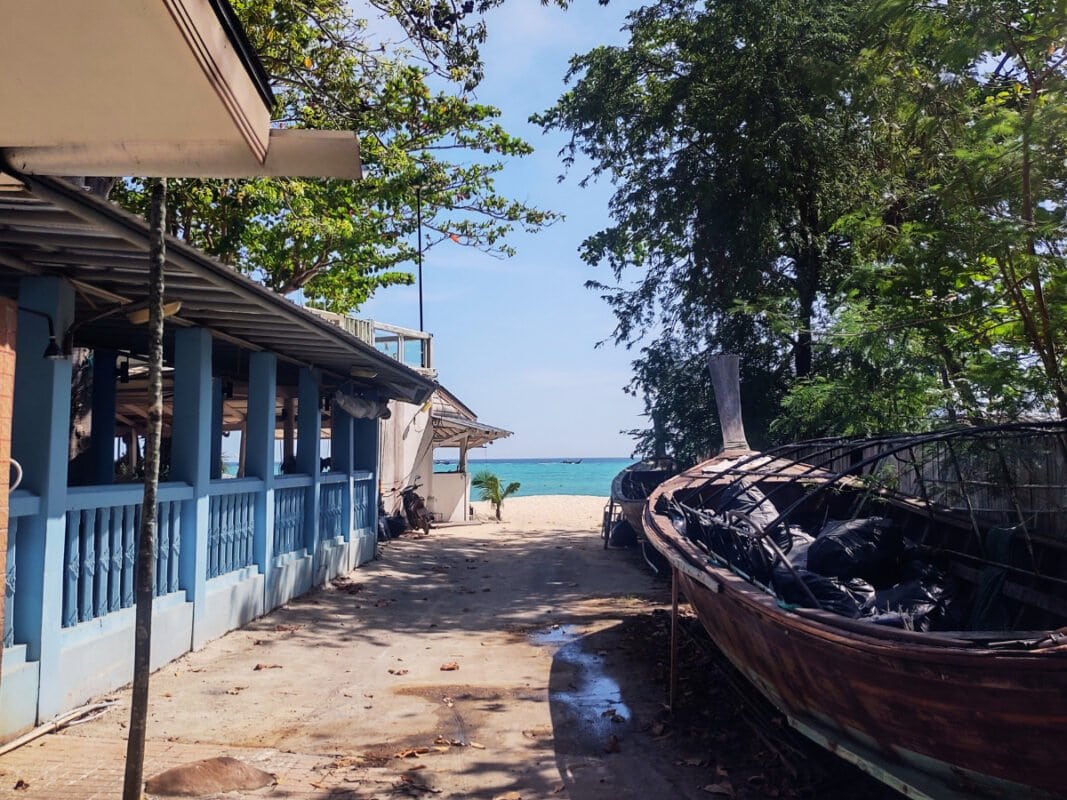
Beaches
Koh Lipe
Koh Lipe’s beaches, including Pattaya Beach, Sunrise Beach, and Sunset Beach, are some of the best in Thailand, with powdery white sand and crystal-clear waters. Often referred to as the “Maldives of Thailand,” Koh Lipe truly lives up to this reputation.
While Pattaya Beach can get busy, it never feels overcrowded, even during high season, and you can always find a spot for yourself. Sunrise Beach and Sunset Beach provide quieter alternatives, with charming beach bars and a relaxed atmosphere.
Koh Lipe is known for its excellent snorkeling, with designated zones for swimming away from boat traffic. Kayak rentals and snorkeling equipment are readily available, allowing you to explore nearby reefs and smaller islands at your own pace.
Pros: Stunning white sandy beaches and turquoise waters, excellent snorkeling off the beach.
Cons: Beaches can sometimes get busy with boats and tourists
Koh Mook
Koh Mook’s beaches, Charlie Beach and Sivalai Beach, offer a peaceful, uncrowded environment, perfect if you want to escape busier tourist spots.
The island is relatively quiet with limited facilities, but at Charlie Beach, you can rent a kayak, enjoy fresh Thai food from local food stalls, and take in the stunning sunset.
Sivalai Beach is known for its sunrises and scenic walks, offering plenty of space and a large resort nearby.
Koh Mook is also home to secluded rocky beaches, which can be discovered through jungle hikes, providing a sense of adventure for explorers.
The famous Emerald Cave is a must-do, where you swim through a tunnel to a hidden lagoon—a unique and memorable experience for adventurers.
Pros: Quiet, uncrowded beaches, basic tourist amenities, and a rustic atmosphere.
Cons: Beaches are not as pristine as other islands, and snorkeling isn’t as good directly from the shore.
Koh Lanta
Koh Lanta’s 13-mile long west coastline offers a variety of beaches, from the more developed Klong Dao Beach to quieter, less crowded spots like Bamboo Bay, all with stunning sunset views.
Even during high season, the beaches remain relatively peaceful compared to other popular destinations. You’ll find plenty of restaurants and beach bars, but the atmosphere is laid-back with limited nightlife.
Kayak rentals are available on many beaches, and while snorkeling directly from the beach isn’t common, day trips to nearby islands like Koh Rok and Koh Haa offer excellent underwater experiences.
On the east coast, while there are no sandy beaches, you can explore mangroves and hidden coves by kayak or visit Lanta Old Town.
Pros: Wide range of spacious, uncrowded beaches, kayak rentals available.
Cons: Beaches aren’t as picturesque as Koh Lipe, and on-island snorkeling is limited; nightlife is minimal.
Koh Phi Phi
Koh Phi Phi is famous for its picturesque beaches, including Loh Dalum Bay, Long Beach, and the quieter Laem Tong Beach.
While Loh Dalum can be crowded due to its proximity to the party scene, quieter spots like Viking Beach offer a more peaceful environment with beautiful views.
The beaches on Koh Phi Phi Don are popular for snorkeling, with some great spots like Shark Point near Long Beach. Kayaks and snorkeling gear rentals are easily available, making it convenient for visitors to explore the surrounding waters.
For a more adventurous experience, you can hike or paddle to secluded coves and hidden beaches, discovering the island’s wilder side.
While central beaches on Koh Phi Phi are easily accessible, reaching the more remote spots like Laem Tong Beach or Loh B Kao Bay requires either a long hike through the jungle or taking a boat.
Pros: Great variety of beaches, from lively to secluded; kayak and snorkeling gear rentals are readily available.
Cons: Some beaches can get very busy with boats and day-trippers; remote beaches are can be hard to access
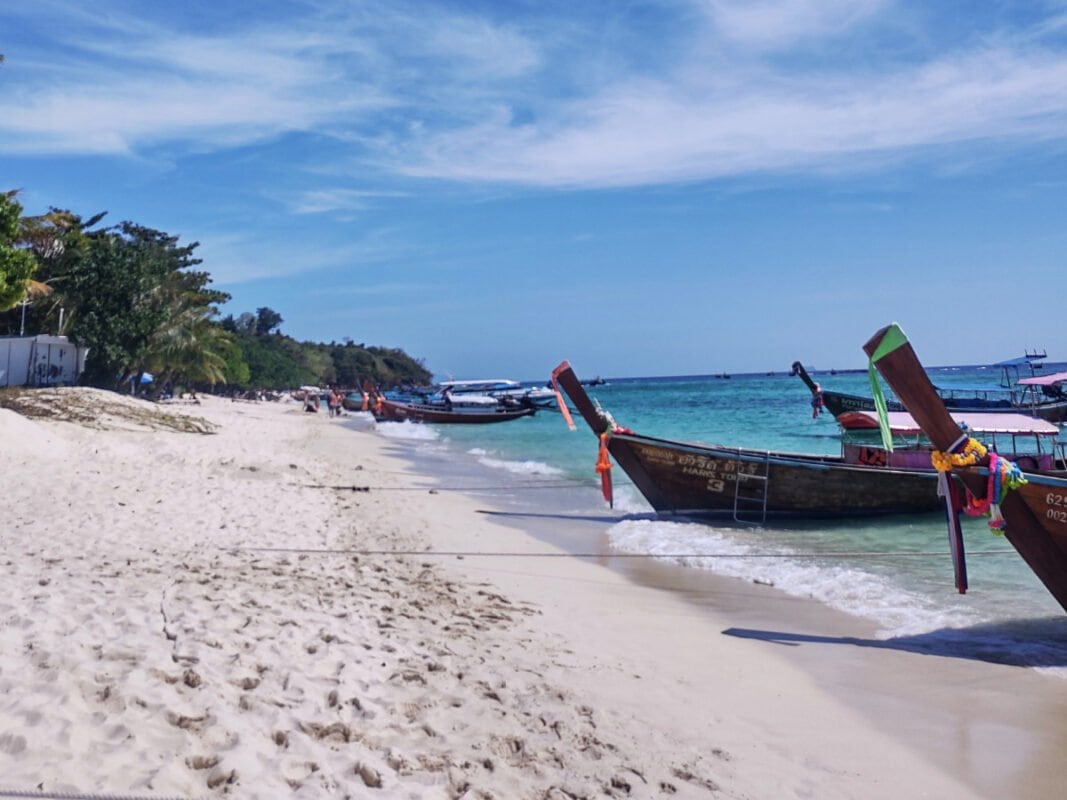
Hiking
Koh Lipe
Due to its small size and being quite developed, Koh Lipe offers fewer hiking opportunities compared to other islands. However, there are some jungle walks to smaller beaches like Pollo and Svedo Beaches, which provide stunning views.
For more challenging hikes, visitors often take a boat to nearby Koh Adang, where the trek to Chado Cliff Viewpoint offers spectacular panoramic views of the surrounding islands.
Pros: Beautiful short walks with great views, access to nearby islands for more serious hiking.
Cons: Limited hiking on the island itself, more focused on beach activities than hiking.
Koh Mook
Koh Mook is a great destination for hikers, with trails that wind through dense jungle and rubber plantations. These trails lead to remote beaches, offering an untouched and authentic natural experience.
The hiking paths vary from easy walks to more challenging treks, making the island suitable for all levels of hikers. Koh Mook remains mostly undeveloped, which adds to the raw beauty and sense of discovery as you trek through its landscapes.
For the more adventurous, hiking to neighboring islands such as Koh Kradan and Koh Ngai is a fantastic way to explore the area.
Pros: Untouched nature, a variety of trails, and access to nearby islands.
Cons: Limited facilities and no marked hiking paths
Koh Lanta
Koh Lanta is ideal for hikers looking to experience a variety of terrains, from easy coastal walks to more strenuous jungle treks and cave exploration.
One of the highlights is hiking in the Mu Ko Lanta National Park, where you can trek through lush jungles and enjoy stunning views of the coast and the nearby lighthouse.
For a more adventurous experience, you can hike to hidden waterfalls, explore Mai Kaeo Cave, or stroll round the mangrove forests. The variety of trails on Koh Lanta makes it a top destination for active, nature loving visitors.
Pros: Diverse terrain, great viewpoints, and plenty of trails in national parks.
Cons: Some trails can be tough, Mai Kaeo Cave requires a guide
Koh Phi Phi
Koh Phi Phi is a destination full of scenic hikes, with the most popular being the climb to the famous viewpoints overlooking the island’s twin bays.
Beyond the viewpoints, a breathtaking coastal path will take you to Long Beach in the south, while a challenging jungle trek leads to Loh Ba Kao Bay and further to Laem Tong Beach in the north.
More demanding jungle trails lead to secluded beaches on both the east and west coasts, passing through dense jungle, sometimes requiring the use of ropes for assistance. Koh Phi Phi is one of the best places for hiking, though it often gets overlooked by visitors.
Pros: Breathtaking views, a wide variety of trails leading to hidden beaches.
Cons: Some places are not easily accessible and can be unsafe at night or during the monsoon season.

Snorkeling and Diving Spots
Koh Lipe
Koh Lipe is a snorkeling and diving paradise, surrounded by the clear waters of Tarutao National Marine Park. The coral reefs are vibrant and well-preserved, offering some of the best snorkeling in Thailand. Popular snorkeling spots include Koh Hin Ngam, Koh Hin Sorn, and Koh Adang, which are part of the 7-Island Tour. The island also has several dive centers and shops with diving gear, making it ideal for both beginners and advanced divers.
Pros: Stunning coral reefs, diverse dive sites, great snorkeling off the beach.
Cons: Can be crowded in high season and slightly more expensive than other islands.
Koh Mook
Koh Mook offers good snorkeling opportunities, especially around nearby islands like Koh Kradan and Koh Ngai. The waters are calm and clear, making it ideal for beginners.
While there are fewer dive centers than on other islands, Koh Mook provides access to great snorkeling and diving around Koh Rok, famous for its vibrant coral reefs.
Pros: Calm waters, ideal for beginners, Emerald Cave adventure.
Cons: Limited diving facilities, fewer dive centers compared to other islands.
Koh Lanta
Koh Lanta is an excellent base for snorkeling and diving, with access to renowned sites like Koh Rok and Koh Haa, where you’ll find colorful coral reefs and diverse marine life.
Snorkeling directly from the beach isn’t as common, as on smaller islands, but tours to the surrounding spots provide some of the best snorkeling in the region.
Koh Lanta also has many diving schools offering courses and trips for both beginners and experienced divers.
Pros: Excellent nearby dive sites, many diving schools.
Cons: Limited beach snorkeling opportunities.
Koh Phi Phi
Koh Phi Phi is famous for its excellent snorkeling and diving spots. Popular dive sites like the Bida Islands and the King Cruiser Wreck feature vibrant marine life, including reef sharks, colorful corals, and various fish species. There are numerous dive centers on the island, catering to all levels of divers.
For snorkelers, Shark Point at Long Beach is the most popular destination, where you can spot blacktip reef sharks right off the shore. Many smaller beaches on Koh Phi Phi are also great for snorkeling, with Nui Beach and Viking Beach being two of the loveliest spots.
Pros: World-class dive sites, excellent snorkeling spots, many dive shops.
Cons: Can be crowded when snorkeling off the beach due to boats and other swimmers.
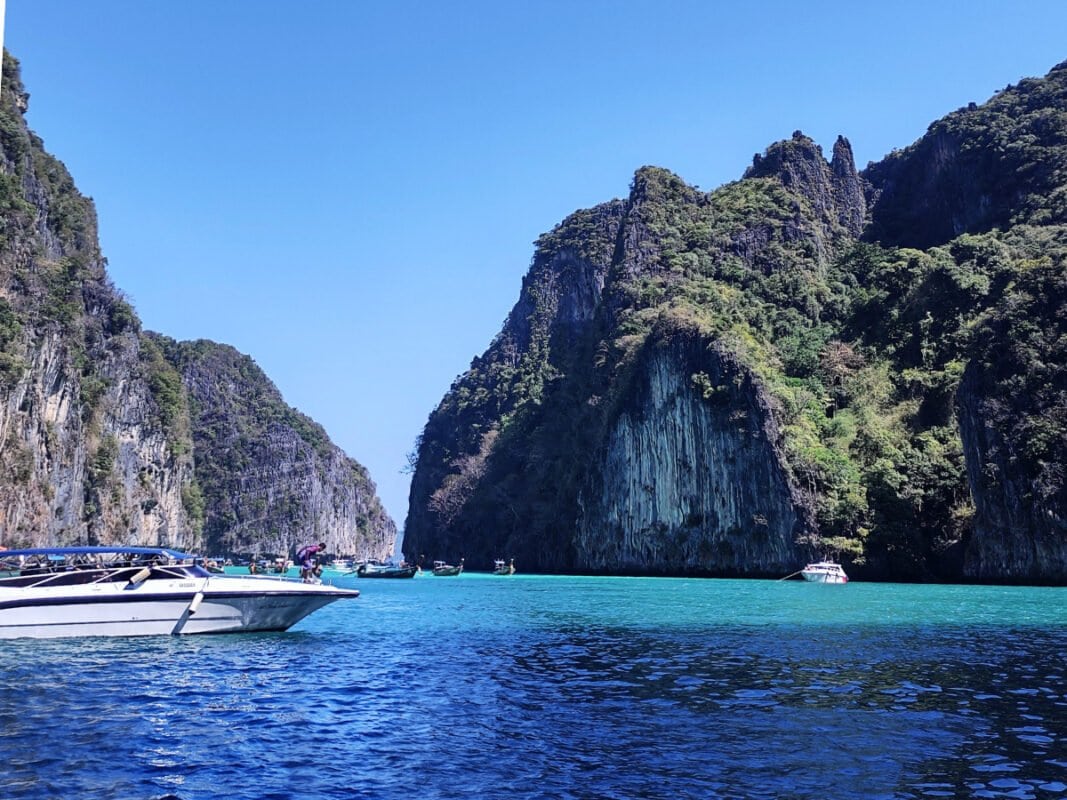
Nightlife
Koh Lipe
Koh Lipe strikes a balance between lively and relaxed nightlife, with Walking Street as the main hub. Here, you’ll find beach bars and restaurants that stay open late, with live music and fire shows by the beach. The atmosphere is vibrant but more laid-back compared to Koh Phi Phi.
Pattaya Beach and Walking Street are the liveliest spots for nightlife, while Sunrise Beach and Sunset Beach offer quieter alternatives for a more peaceful evening.
Pros: Lively yet relaxed nightlife, fire shows, live music, and restaurants open until late.
Cons: Not very quiet, especially near Walking Street.
Koh Mook
Koh Mook is a quiet, serene island with very little nightlife. You’ll find a few low-key beach bars and restaurants, primarily near the pier. Charlie Beach has a few late-night food stalls where you can enjoy a relaxed drink by the sea.
Fire shows and loud parties are absent on Koh Mook, making it a great spot if you prefer more peaceful evenings. Many visitors end their nights early, enjoying dinner by the beach or stargazing.
Pros: Tranquil and rustic atmosphere, with local spots rather than popular tourist restaurants.
Cons: Very limited nightlife options, not ideal if you’re looking for a party scene.
Koh Lanta
Koh Lanta offers a more relaxed nightlife scene with plenty of beach bars, particularly around Klong Khong Beach, where you can enjoy drinks, fire shows, and live music.
The island’s nightlife is laid-back, making it a good option if you are looking for a social but not too loud evening. Klong Nin Beach and Long Beach also have several beachfront spots where you can unwind with a cocktail.
Old Town provides a more local experience, with many restaurants and a Walking Street that fills up with street food in the evenings.
Pros: Relaxed beach bars, fire shows, live music; not too crowded, easy to find a spot for yourself.
Cons: No high-energy party scene.
Koh Phi Phi
Koh Phi Phi is known for its vibrant nightlife, making it a hotspot for party-goers. The nightlife is centered around Tonsai Village and Loh Dalum Bay, where you’ll find beach bars, pool parties, and lively venues offering fire shows and live performances.
Slinky Beach Bar and Ibiza Hostel are popular spots for dancing, while quieter bars can be found farther from the main beach. Reggae Bar also offers Muay Thai fights, where tourists can participate.
The island’s center is alive and crowded until the early hours, but this can be overwhelming for some visitors.
Pros: Lively nightlife, beach parties, fire shows, and dance clubs.
Cons: Can be crowded and noisy, especially during high season.
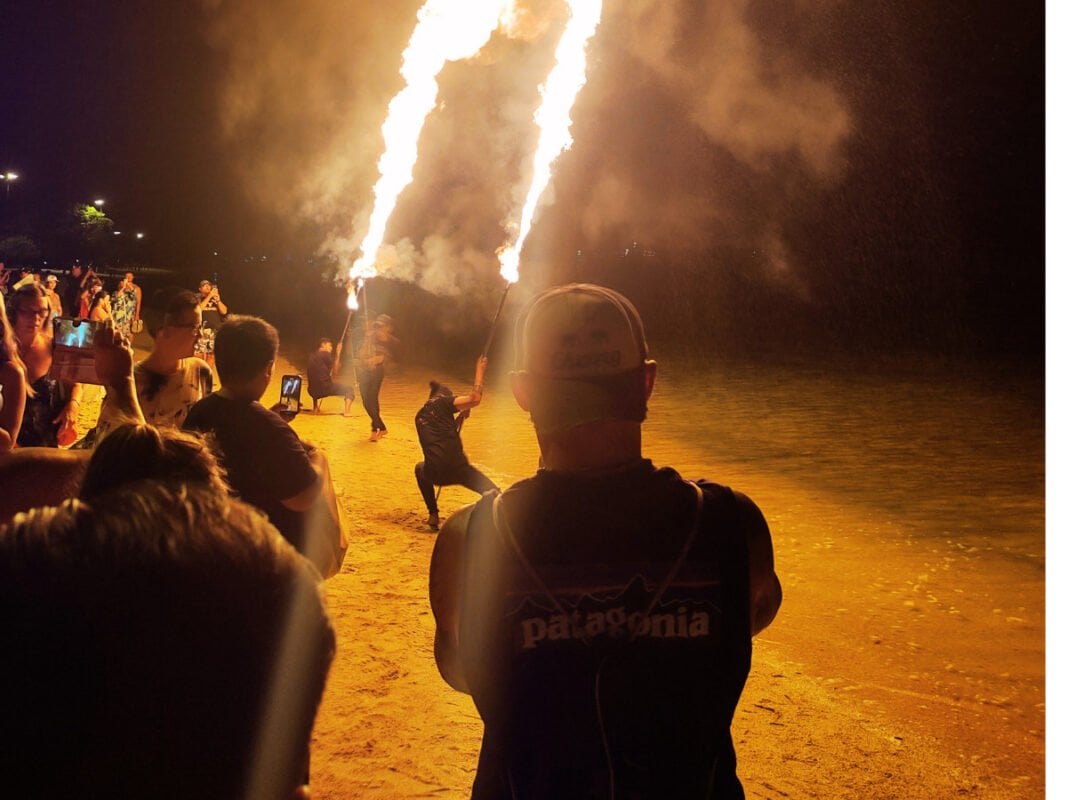
Walkability and Transportation
Koh Lipe
Koh Lipe is a highly walkable island, with most attractions, beaches, and restaurants within a short distance from each other. The island is small enough that you rarely need transportation beyond walking.
Motorbike taxis and tuk-tuks are available for carrying luggage or reaching more remote spots like Sunset Beach, but the flat terrain and compact layout make it easy to explore on foot.
Pros: Very walkable, no need for motorized transport
Cons: Tuk-tuks might be needed to transport luggage if you stay further from the pier
Koh Mook
Koh Mook is a very walkable island, with most attractions, accommodations, and restaurants located within close proximity. The main village and areas near the pier are easily navigated on foot, but reaching Charlie Beach requires a bit more effort and a longer walk.
For convenience, you can rent bicycles, mopeds, or hire tuk-tuks to get around. There are no cars on the island, making it peaceful and free from traffic noise. Sivalai Beach also offers accommodation closer to the beach, but many budget-friendly bungalows are located farther inland.
Pros: Quiet, walkable, no cars, peaceful atmosphere.
Cons: Longer walks to some beaches
Koh Lanta
Koh Lanta is a large island, and while some areas are walkable, such as the Old Town and Saladan Pier area, most visitors rely on mopeds or cars to explore the island’s many beaches and attractions.
Renting a moped is one of the most popular and cost-effective ways to get around. Alternatively, tuk-tuks and taxis are widely available, but they can be more expensive if used frequently.
The island is connected to the mainland by bridge and car ferry, which adds to its accessibility.
Pros: Easy access to transportation options, good infrastructure.
Cons: Walking is not feasible for exploring the entire island, relying on scooters or taxis.
Koh Phi Phi
Koh Phi Phi is a small, easily walkable island, especially around Tonsai Village and Loh Dalum Bay. There are no cars or motorbikes around Tonsai Pier, contributing to a relaxed and pedestrian-friendly atmosphere.
Most visitors get around on foot. For trips to more remote beaches, such as Laem Tong Beach or Long Beach, boat taxis are a popular alternative to hiking. If you decide to stay in one of more peaceful and secluded destinations on Koh Phi Phi you will need to plan transportation more carefully.
Pros: Center area is very walkable
Cons: Remote beaches can only be accessed by long hikes or by boat
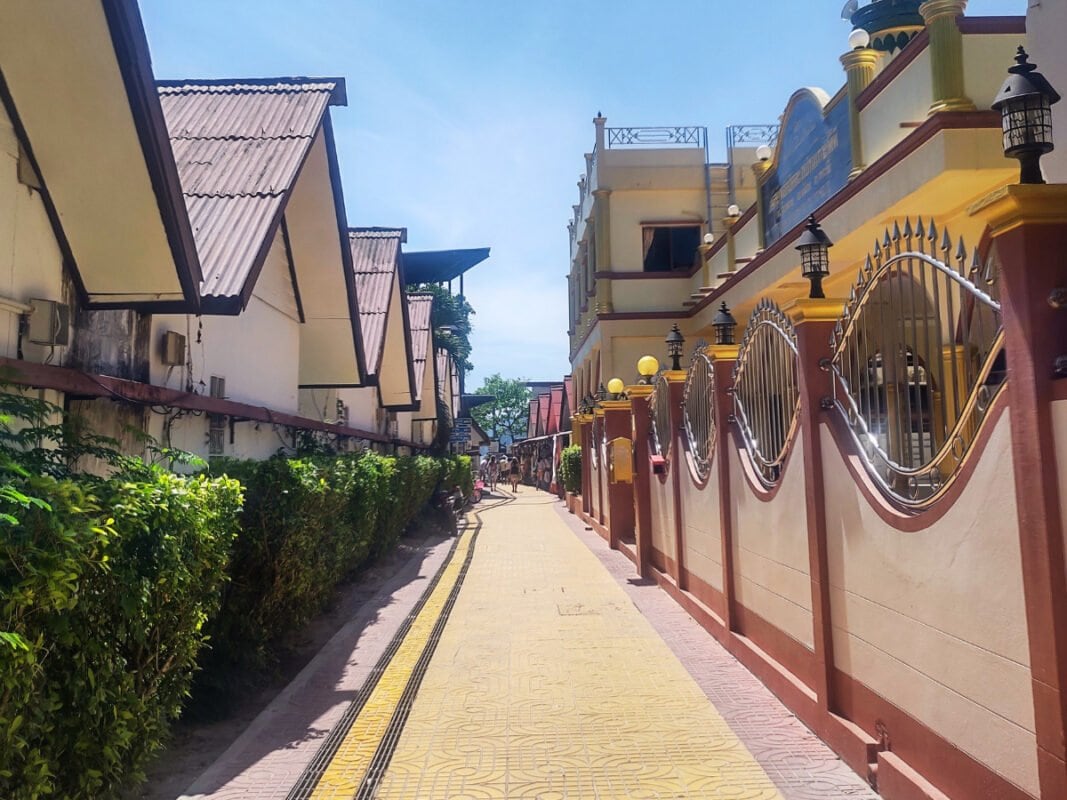
Authentic and Unique Activities
Koh Lipe
Koh Lipe is a small, lively island with a focus on pristine beaches and outdoor experiences. The Urak Lawoi Community Center offers an authentic look into the Thai sea people culture, adding a unique cultural element to the island.
If you are seeking adventure, a short boat ride to Koh Adang provides more challenging hikes and the island’s location within Tarutao National Marine Park also means opportunities for wildlife spotting and nature walks are plentiful.
Pros: Urak Lawoi community center, stunning nature walks.
Cons: Can feel crowded during peak times, with limited truly secluded spots.
Koh Mook
Koh Mook is one of the most authentic and least touristy islands in the region, offering a glimpse into traditional Thai island life at a slower pace. Small fishing villages like Baan Koh Mook highlight the island’s rural charm, with a lifestyle centered around fishing.
One of Koh Mook’s most famous attractions is the Emerald Cave, where you swim through a dark cave to reach a hidden lagoon. Although it can get crowded, it’s a truly unique adventure worth experiencing.
The island is also covered in jungle, providing numerous hiking opportunities and access to wild, secluded beaches waiting to be discovered.
Pros: Preserved local culture, rustic vibe, and peaceful environment.
Cons: Limited modern amenities and infrastructure compared to more developed islands.
Koh Lanta
Koh Lanta strikes a perfect balance between tourist development and local culture. Its size allows for a wide range of unique experiences, from visiting an animal shelter and an ethical elephant sanctuary to exploring Koh Por, a nearby island with a traditional fishing community.
Renting a scooter to explore hidden beaches and local spots is a fantastic way to discover the island on a road trip. The mangrove forests are also worth exploring, whether by kayak or on foot, offering peaceful escapes into nature.
Lanta Old Town, with its wooden houses, small temples, and local community museum, is a must-visit for history lovers.
Koh Lanta also offers plenty of hiking opportunities, with villages and a national park featuring trekking paths, caves, and waterfalls.
Pros: Cultural diversity, plenty of outdoor activities, and traditional experiences.
Cons: Some areas are harder to reach, and transportation is needed
Koh Phi Phi
Koh Phi Phi is known for its lively activities and heavy tourist development, particularly in Tonsai Village. However, you can still find unique experiences, such as Muay Thai boxing matches, which allow tourists to participate while showcasing traditional Thai boxing.
Koh Phi Phi also offers fantastic hiking opportunities, with trails leading to remote areas and local villages. For those looking to escape the crowds, kayaking around limestone cliffs and visiting secluded beaches provide a more serene and peaceful experience.
The most popular activity when visiting Koh Phi Phi is a day trip to Maya Bay, but this spot is almost always overcrowded and although the views are stunning it’s not the most unique experience.
Pros: Muay Thai boxing matches, many jungle treks, hidden beaches.
Cons: Overdeveloped and crowded center of the island.

Accommodation and Prices
Koh Lipe
Koh Lipe is known for being the most expensive of the four islands, especially when it comes to accommodation. Even budget guesthouses tend to be pricier due to its small size and remote location.
Upscale resorts and beachfront bungalows dominate the accommodation scene, particularly around Pattaya Beach and Sunrise Beach.
Food, activities, and transportation are, fortunately, as affordable as on other islands.
For remote workers, Koh Lipe offers decent Wi-Fi, although finding a spacious room on a tight budget might be hard.
Pros: Decent Wi-Fi and data coverage, affordable food and activities.
Cons: Expensive compared to other islands, limited budget choices.
Koh Mook
Koh Mook is the most budget-friendly of the four islands. Accommodations range from affordable bungalows and guesthouses, though these are typically located away from the beach. More upscale options are available at Sivalai Beach.
Restaurants, local shops, and moped rentals are all reasonably priced.
For remote work, internet connectivity can be limited. Staying closer to the main village may provide slightly better Wi-Fi access, but Koh Mook is not ideal for those needing reliable internet.
Pros: Affordable accommodations and activities, peaceful and rustic atmosphere.
Cons: Limited luxury options, fewer beachfront accommodations, and inconsistent internet for remote work.
Koh Lanta
Koh Lanta offers a broad range of accommodations to suit all types of travelers. Budget options are available further inland, while premium resorts are located near the beach.
Transportation costs, such as renting scooters or tuk-tuks, can add up due to the island’s larger size.
For remote workers, Koh Lanta is well-suited, offering reliable Wi-Fi and spacious accommodations.
Pros: Wide range of prices, diverse accommodations, good for remote work.
Cons: Transportation costs can add up due to the island’s size; cheaper accommodation is often further from the beach.
Koh Phi Phi
Koh Phi Phi’s accommodation falls into the mid-range category, with budget hostels and guesthouses alongside more expensive hotels and resorts. Due to its popularity, prices can spike significantly during the high season or when booked last minute.
While it’s possible to find affordable lodging in Tonsai Village, the more tranquil areas near the beach are typically more expensive.
Meals and activities are as affordable as on other southern islands. There is a wide range of both more expensive Western-style restaurants and affordable local places or street food.
Since Koh Phi Phi Don is quite developed, Wi-Fi for remote work is generally reliable in Tonsai Village, but staying in more secluded areas might mean less dependable internet access.
Pros: Wide variety of accommodation options, affordable food and activities, reliable Wi-Fi for remote work.
Cons: Pricey during high season, crowded in central areas.

Safety
All four islands—Koh Lanta, Koh Lipe, Koh Phi Phi, and Koh Mook—are generally safe for travelers. The laid-back atmosphere and friendly locals contribute to an overall sense of security.
However, it’s important to take standard precautions, such as being mindful of your belongings at crowded locations like beaches or markets.
When hiking, especially in jungle areas, make sure to bring sufficient water and wear appropriate shoes to avoid accidents on rugged trails.
Stray dogs are common but usually pose no danger, as they are used to human presence.
Be mindful of changing weather conditions, especially during the monsoon season, when rough seas can make boat travel and water sports more hazardous.
Pros: Friendly locals, safe for solo travelers, low crime rates.
Cons: Possible petty theft in tourist areas, seasonal risks with water activities.
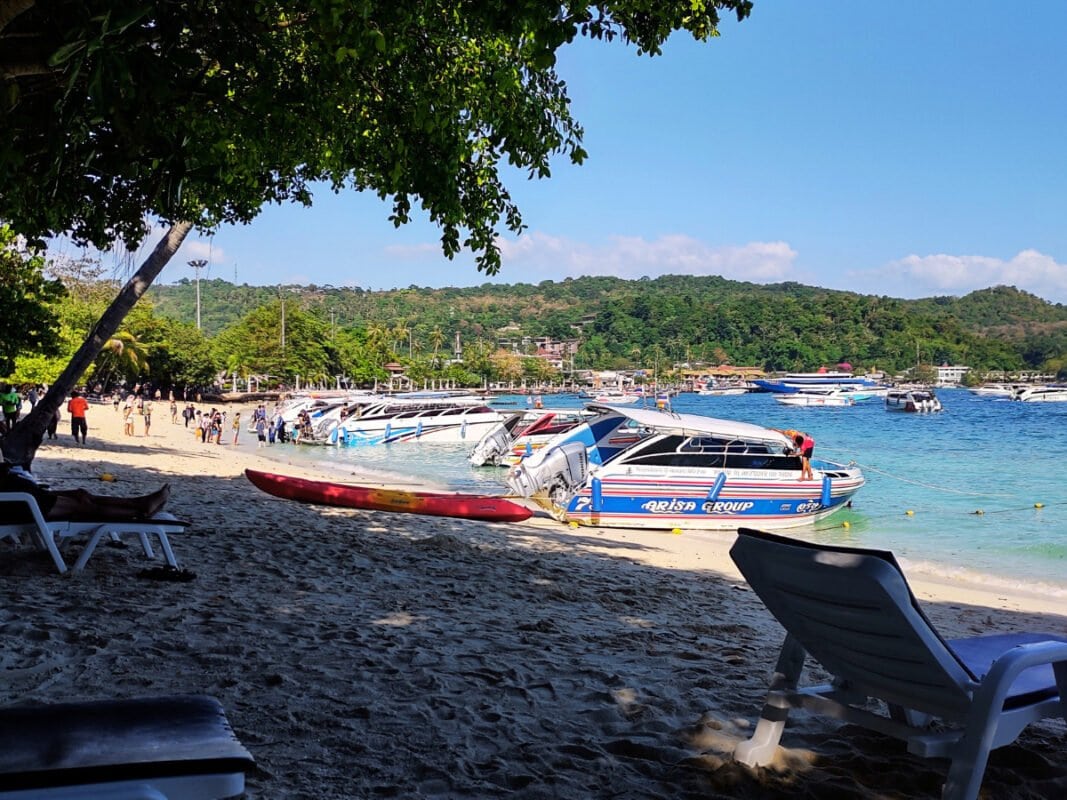
Final Thoughts
For unique, authentic experiences and outdoor adventure, Koh Mook is the top choice for an immersive, off-the-beaten-path trip with untouched nature and quiet charm.
If you’re seeking a variety of activities, Koh Lanta offers the perfect mix of adventure and local culture, from hiking to exploring Old Town.
Koh Lipe is a tropical paradise with pristine white sandy beaches and turquoise water, ideal for those seeking a relaxing island escape.
For lively nightlife paired with jungle hikes, Koh Phi Phi delivers the best of both worlds, with scenic trails and vibrant social scenes.
Table Summarizing Comparison Koh Lipe vs. Koh Mook vs. Koh Lanta vs. Koh Phi Phi
| Category | Koh Lipe | Koh Mook | Koh Lanta | Koh Phi Phi |
| Location | Southernmost Thai island, 60 km from Langkawi, near Koh Adang. Accessible from Bangkok via a 1.5-hour flight to Hat Yai or Trang, followed by a van ride and a 1-2 hour boat ride. | Small island in Trang Province, close to Koh Kradan and Koh Ngai. Accessible from Bangkok with a 1.5-hour flight to Trang, followed by a short van and boat ride. | Large island, Krabi Province, 70 km south of Krabi Town. Easily accessible from Bangkok via a 1.5-hour flight to Krabi, followed by a 2.5-hour drive. | Central in Andaman Sea, between Krabi, Phuket, and Koh Lanta. Accessible via a 1.5-hour flight to Krabi or Phuket from Bangkok, then a ferry or speedboat (1-2 hours). |
| Hiking | Limited hiking on the island; nearby Koh Adang offers challenging trails. | Jungle trails through rubber plantations leading to secluded beaches. | Diverse terrain, from coastal walks to jungle treks in Mu Ko Lanta National Park. | Scenic hikes to viewpoints, remote beaches, and jungle trails. |
| Beaches | Stunning white sandy beaches, often referred to as the “Maldives of Thailand.” | Peaceful, uncrowded beaches like Charlie Beach; known for sunrises at Sivalai Beach. | Wide range of beaches from developed to secluded, with sunset views. | Picturesque beaches like Loh Dalum Bay and Long Beach, with snorkeling spots. |
| Snorkeling & Diving | Excellent snorkeling and diving within Tarutao National Marine Park. | Good snorkeling around nearby islands like Koh Kradan and Koh Ngai. | Great access to dive sites like Koh Rok and Koh Haa; snorkeling trips recommended. | World-class dive spots like Bida Islands; Shark Point is a popular snorkeling site. |
| Nightlife | Lively yet relaxed, centered around Walking Street and beach bars. | Quiet, with a few beach bars and late-night food stalls. | Laid-back beach bars with live music and fire shows, especially at Klong Khong Beach. | Vibrant nightlife with beach bars, fire shows, and dance clubs. |
| Authenticity | Mix of tourism and cultural heritage from the Urak Lawoi community. | One of the most authentic islands with local fishing villages and rustic charm. | Balance of local culture and tourism; Old Town provides an authentic glimpse into island life. | Heavily developed with a tourist focus, though remote spots offer more natural beauty. |
| Price Range | The most expensive of the islands, particularly for accommodation. | Very budget-friendly with simple bungalows and guesthouses. | Broad range, from budget guesthouses to luxury resorts near the beach. | Mid-range with some budget options, but prices spike during high season. |
| Unique Activities | Urak Lawoi culture center, hikes to Koh Adang, and wildlife spotting. | Emerald Cave adventure, small fishing villages, jungle hikes to secluded beaches. | Animal sanctuaries, elephant treks, mangrove kayaking, exploring Lanta Old Town. | Muay Thai matches, kayaking, and boat tours to nearby islands. |
| Transportation | Highly walkable, with tuk-tuks and motorbike taxis for luggage transport. | Walkable, with tuk-tuks and mopeds available; no cars on the island. | Larger island, requiring scooters or tuk-tuks for transport; well-connected to the mainland. | Walkable around Tonsai Village; boats needed for more remote beaches. |
| Accommodation | Dominated by upscale resorts and beachfront bungalows. | Simple bungalows and guesthouses; Sivalai Beach offers upscale options. | Budget inland options to premium beachfront resorts. | Budget hostels in Tonsai Village; more expensive hotels near the beach. |
| Prices | The most expensive of the islands; accommodation and food are pricier, especially in high season. | Very budget-friendly with affordable accommodations and food options. | Wide range of prices, with budget, mid-range, and luxury accommodations available. | Mid-range prices, but can become expensive during high season, especially for accommodation. |
| Remote Work | Decent Wi-Fi, but budget accommodations are harder to find. | Limited Wi-Fi and data coverage; best near the main village. | Reliable Wi-Fi; several co-working spaces | Decent Wi-Fi in Tonsai Village, but less reliable in more remote areas. |
Read My Other Posts about Visiting Koh Phi Phi:
- Unforgettable 4 Days on Koh Phi Phi, Thailand – Detailed Itinerary (2024)
- 24 Hours on Koh Phi Phi, Thailand – Detailed Itinerary (2024)
- 11 Best Hikes on Koh Phi Phi Don, Thailand – Detailed Guide (2024)
- How to Do Coastal Hike to Long Beach (Haad Yao) on Koh Phi Phi – Detailed Guide (2024)
- How to Do Jungle Hike to Loh Ba Kao Bay on Koh Phi Phi – Detailed Guide (2024)
- How to Visit Famous Maya Bay in Koh Phi Phi, Thailand? – Detailed Guide and Review (2024)
- 17 Best Beaches on Koh Phi Phi, Thailand – Ultimate Guide (2024)
- 23 Pros and Cons of Visiting Koh Phi Phi, Thailand – 2024 Guide
- How to Travel to Koh Phi Phi from Bangkok and Other Places – 2024 Guide

